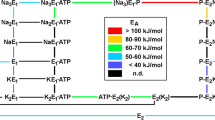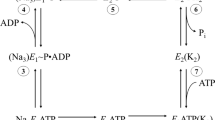Summary
Phenytoin (Diphenylhydantoin, DPH) did not activate Na+, K+-ATPase activity prepared from both canine cardiac and renal tissues at any ratio of NA+ to K+ instandard assay medium and this drug failed to relieve the inhibitory effect of ouabain on Na+, K+-ATPase. With the Na+, K+-ATPase partially purified from the cardiac tissue the maximum number of ouabain binding sites was 50 pmol ouabain per mg enzyme and the dissociation constant (Kd) was 4×10−8 mol/l. Scatchard analysis of ouabain binding to Na+, K+-ATPase indicates that DPH did not significantly alter these parameters. The relase of ouabain from Na+, K+-ATPase and ouabain complex was also not significantly influenced by DPH which indicates that the antiarrhythmic action of DPH against digitalis-induced arrhythmia is not due to a simple displacement of ouabain from Na+, K+-ATPase molecules.
Similar content being viewed by others
Abbreviations
- Na+, K+-ATPase:
-
(Mg2+-dependent, sodium plus potassium) activated adenosinetriphosphatephohydrolase (E.C., 3.6.1.3)
- DPH:
-
5,5′-diphenylhydantoin (phenytoin)
References
Akera T, Brody TM, So RH-M, Tobin T, Baskin SI (1974) Factors and agents that influence cardiac glycoside-Na+, K+-ATPase interaction. In: Askari A (ed) Properties and functions of (Na+, K+)-activated adenosinetriphosphatase. Ann NY Acad Sci 242:617–634
Atkinson AJ, Jr, Davidson R (1974) Diphenylhydantoin as an antiarrhythmic drug. Ann Rev Med 25:99–113
Baskin SI, Dutta S, Marks BH (1973) The effects of diphenylhydantoin and potassium on the biological activity of ouabain in the guinea pig heart. Br J Pharmacol 47:85–96
Bigger JT, Jr, Bassett AL, Hoffman B (1968) Electrophysiological effect of DPH on canine Purkinje fibers. Circ Res 22:221–236
Bigger JT, Jr, Weinberg DI, Kovalik TW, Harris PD, Cranefield PC, Hoffman BF (1970) Effect of diphenylhydantoin on excitability and automaticity in the canine heart. Circ Res 26:1–15
Binnion PF, DasGupta R, (1975) Tritiated digoxin metabolism after prior treatment with propranolol, or diphenylhydantoin sodium. Int J Clin Pharmacol 12:96–101
Chai CY, Lee TM, Wang SC (1976) Effects of diphenylhydantoin on cardiac arrhythmias induced by carotid occlusion in the cat. Arch Int Pharmacodyn 219:180–192
Damato AN (1969) Diphenylhydantoin: Pharmacological and clinical use. Progr Cardiovasc Dis 12:1–15
Deutscher RN, Harrison DC, Goldman RH (1972) The relation between myocardial 3H-digoxin concentration and its hemodynamic effect. Am J Cardiol 29:47–55
Dutta S, Rhee HM, Marks BH (1974) 3H-ouabain accumulation and Na+, K+-ATPase activity in relation to therapeutic, toxic and lethal doses of ouabain in dogs. In: Dhalla NS (ed) Recent advances in studies on cardiac and metabolism. Myocardial biology, vol. 4. University Park Press, Baltimore pp 119–130
Festoff BW, Appel SH (1968) Effect of diphenylhydantoin on synaptosome sodium-potassium-ATPase. J Clin Invest 47:2752–2758
Fiske CH, Subbarow Y (1925) The colorimetric determination of phosphorus. J Biol Chem 66:375–400
Gibson K, Harris P (1969) Diphenylhydantoin and human myocardial microsomal (Na+, K+)-ATPase. Biochem Biophys Res Commun 35:75–78
Godfraind T, Lasne M, Pousti A (1971) The action of diphenylhydantoin upon drug binding, ionic effects and inotropic action of ouabain. Arch Int Pharmacodyn Ther 191:66–73
Goldstein RE, Penzotti SC, Kuehl KS, Prindle KH, Hall CA, Titus EO, Epstein SE (1971) Correlation of antiarrhythmic effects of diphenylhydantoin with digoxin-induced changes in contractility, Na+, K+-ATPase and K+ efflux. Clin Res 19:708
Helfant RH, Scherlag BJ, Damato AN (1967) The electrophysiological properties of diphenylhydantoin sodium as compared to procaine amide in the normal and digitalis-intoxicated heart. Circ 36: 108–118
Hoffman BF (1966) The genesis of cardiac arrhythmias. Progr Cardiovasc Dis 8:319–329
Lee KS, Klaus W (1971) The subcellular basis for the mechanism of intropic action of cardiac glucosides. Pharmacol Rev 23:193–261
Lowry OH, Rosebrough NJ, Farr AL, Randall RJ (1951) Protein measurement with the Folin phenol reagent. J Biol Chem 193:265–275
Luchi RJ, Park CD, Waldhausen JA (1971) Relationship between myocardial ouabain content and intropic activity. Am J Physiol 220:906–910
Mason DT, Spann JF Jr, Zelis R (1969) New developments in the understanding of the actions of the digitalis glycosides. Progr Cardiovasc Dis 11:443–478
Mason DT, Amsterdam EA, Massumi RA, Mansour EJ, Hughes JL III Zelis R (1973) Combined actions of antiarrhythmic drugs. In: Dreifus LS, Likoff W (ed) Electrophysiologic and therapeutic considerations. Grune and Stratton, New York p 531
Rhee HM, Dutta S (1983) Antiarrhythmic mechanism of phenytoin: Effect of phenytoin on the binding of 3H-ouabain to Na+, K+-ATPase in intact dog hearts. In preparation.
Rhee HM, Hokin LE (1979) Inhibition of ouabain binding to (Na+, K+)-ATPase by antibody against the catalystic subunit but not by antibody against the glycoprotein subunit. Biochim Biophys Acta 558:108–112
Rhee HM, Dutta S, Marks BH (1976) Cardiac Na+, K+-ATPase activity during positive inotropic and toxic actions of ouabain. Eur J Pharmacol 37:141–153
Rosati RA, Alexander JA, Schaal SF, Wallace AG (1967) Influence of diphenylhydantoin on electrophysiological properties of the canine heart. Circ Res 21:757–765
Rosen MR, Danilo P, Jr, Alonso MB, Pippenger CE (1976) Effects of therapeutic concentrations of diphenylhydantoin on transmembrane potentials of normal and depressed Purkinje fibers. J Pharmacol Exp Ther 197:594–604
Sasyniuk BI, Ogilvie RI (1975) Antiarrhythmic drugs: Electrophysiological and pharmacokinetic considerations. Ann Rev Pharmacol 15:131–155
Schwartz A, Lindenmayer GE, Allen JC (1975) The sodium and potassium adenosine triphosphatase: Pharmacological, physiological and biochemical aspects. Pharmacol Rev 27:3–134
Smith TW, Haber E (1971) The clinical value of serum glycoside concentration in the evaluation of drug toxicity. Ann NY Acad Sci 179:322–337
Spain RC, Chidsey CA (1971) Myocardial Na+, K+-adenosine triphosphatase activity during the reversal of ouabain toxicity with diphenylhydantoin. J Pharmacol Exp Ther 179:594–598
Author information
Authors and Affiliations
Rights and permissions
About this article
Cite this article
Rhee, H.M. Evidence against an involvement of Na+, K+-ATPase in antiarrhythmic mechanism of phenytoin. Naunyn-Schmiedeberg's Arch. Pharmacol. 323, 78–84 (1983). https://doi.org/10.1007/BF00498832
Received:
Accepted:
Issue Date:
DOI: https://doi.org/10.1007/BF00498832




